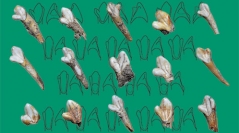

 Comptes Rendus Palevol
20 (25) - Pages 539-553
Comptes Rendus Palevol
20 (25) - Pages 539-553Morphometric and morphotypic variability of the cave bear lower incisors from two different geographic regions (Caucasus and Urals), different stratigraphic periods (Middle and Late Pleistocene), and bearing different mitochondrial haplogroups (kudarensis (Baryshnikov, 1985) and ingressus Rabeder, Hofreiter & Withalm, 2004) was studied. Urals Ursus kanivetz Vereshchagin, 1973 is clearly distinguished from Caucasian U. kudarensis by morphology of the upper and lower incisors. The Urals cave bear exhibits more derived features compared to the Caucasian cave bears. Ursus kanivetz exhibits the largest average size of the lower incisors. The lower incisors of U. kanivetz are clearly distinct from those in U. kudarensis. Also, U. kudarensis specimens display a clear separation from all other groups of cave bears. Morphology of the incisors of the cave bears is clearly different from that of Early Pleistocene U. etruscus G. Cuvier, 1823, as well as from that of recent U. arctos L., 1758 (Rabeder, 1999) and U. maritimus Phipps, 1774. Our results suggest that the incisors of the cave bears are similar to each other and demonstrate a hypocarnivorous adaptation as a major evolution trend in the lineage of Spelearctos group. These adaptation features were perhaps developed in parallel in different lineages of the cave bears (U. spelaeus Rosenmüller, 1794 and U. kanivetz on the one hand and U. kudarensis on the other hand) in the Late Pleistocene.
Carnivora, Ursidae, Pleistocene, Caucasus, Ural, cave bears, morphotypes, size, variations, lower incisor